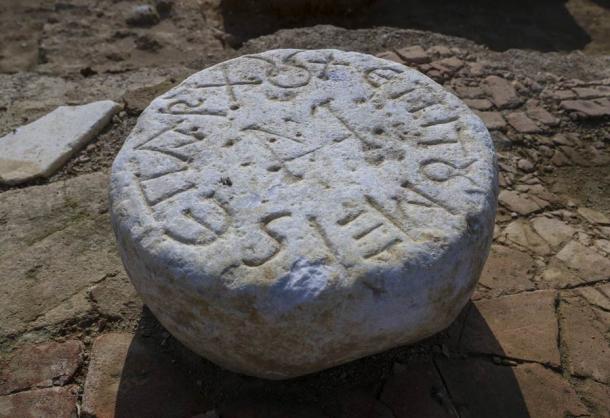
Rare Hellenistic Cremation Burial Found in Turkey in 2,300-Year-Old Tomb
A rare 2,300-year-old Hellenistic cremation burial has been discovered in Istanbul. Artifacts discovered in the Hellenistic-era burial tomb are revealing secrets about the city of ancient Chalcedon, which is now within the boundaries of modern-day Istanbul. Greek colonists from Megara in Attica founded the Hellenistic settlement of Chalcedon in 685 BC.
The 235-220-BC Hellenistic cremation burial tomb containing the cremated remains of at least one person was found beneath the historical Haydarpaşa train station in the Kadıköy district of Istanbul. This area was part of Chalcedon (Kadıköy) an ancient maritime town of Bithynia, in Asia Minor, located on a small peninsula on the north coast of the Sea of Marmara, near the mouth of the Bosphorus.
Noah Kaye, an assistant professor of history at Michigan State University, told LiveScience at the time the tomb was built “Chalcedon was a powerful player in international politics.” Between 235 BC and 220 BC Chalcedon and Byzantion (a nearby city) “levied heavy tolls on ships passing through the Bosphorus strait, which separates Asia from Europe, into the Black Sea.” These two cash generating cities were protected by the Ptolemaic dynasty of Egypt, who provided ships from the Egyptian navy.

Archaeologists and staff at work at the Haydarpaşa excavation area in Kadıköy, Istanbul, which was where the rare Hellenistic cremation tomb was discovered along with other new artifacts. (Anadolu Agency)
Train Station Dig Reveals Hellenistic Cremation Burial Tomb
Located on the Asian side of Istanbul, the archeological excavations around Haydarpasa train station have unearthed the foundations of many buildings from the ancient city of Chalcedon, also known as the “Land of the Blind.” Turkey's Culture and Tourism Ministry and Istanbul Archeological Museums began digging in this area in 2018. A 2020 Hurriyet Daily News article said many historical structures had been identified from the Ottoman, Byzantine, Hellenistic, and Classical eras.
- Evidence Of Viking Mercenary District Found Near Istanbul
- 8,500-year-old footprints and graves are rewriting the history of Istanbul
While many buildings have been excavated at ancient Chalcedon, archaeologists have only found some artifacts so far. Rahmi Asal, director of the Istanbul Archaeological Museums, told the Turkish government-owned Anadolu Agency the recent discovery of the body and grave goods “will give us many more valuable insights into the secrets of ancient Chalcedon.”

A pedestal inscribed in Greek, which likely was part of a mausoleum, found at the huge train station dig in Istanbul. (Anadolu Agency)
Some Of The Oldest Discoveries In The Region
The excavation was carried out at the Haydarpaşa train station in Istanbul prior to the renovation and expansion of the Marmaray Project rail system. This 76.3 kilometer (48 mile) high-capacity metro style railway connects Europe and Asia across the Istanbul Strait, and when it was opened in 2014 it was considered to be the deepest immersed structure in the world, at 55 meters (180 feet) below sea level.
Primary analysis of the Hellenistic cremation burial showed that the body was laid out in the tomb before being set on fire. Asal said he has never seen this type of a cremation tomb from the Hellenistic period. Furthermore, beside the cremated body the archaeologists found a terracotta goblet and a perfume bottle which Asal said are “very valuable because they represent one of the oldest finds in this area.”
Digging Into The Council Of Chalcedon
Felix Pirson, director of the German Archaeological Institute's Istanbul branch, told LiveScience the discovery of the tomb “may help shed light on what Chalcedon was like before Constantinople was founded.” Pirson added that burial customs and funerary culture, in general, “sheds a light on crucial topics such as social differentiation or identities.” Thus, he said the cremated body and artifacts are of the “utmost importance.”
- Riches Unearthed in Turkey’s ‘Land of the Blind’
- Striking Grave Goods Begin to Shed Light on Hellenistic Life in Turkey
This ancient city is where the Roman Emperor Marcian held the 451 AD Council of Chalcedon to settle historic debates regarding the hypostases (reality) of Christ. It was here that the question was asked as to whether Christ was human, divine, or both. The implications of the answers to these questions affected whether Jesus had the power to forgive sins and offer eternal life, or not. The Council of Chalcedon’s decisive creed determining the divinity of Christ is why today Christians agree that Jesus is fully man and the totality of God.
Top image: The Hellenistic cremation burial remains found in a 2,300-year-old tomb in the ancient city of Chalcedon that is now part of modern-day Istanbul, Turkey. Source: Sebnem Coskun / Anadolu Agency
By Ashley Cowie
















Comments
Known as the land, or city of the blind. Simply because classical Greeks could never understand how the colonists, given the choice of the entire area, chose to settle on the asian side of the sea of Marmara, and not on the Goden Horn - a much better site strategically
When cities of stone become ruins, and called the “land of the blind”, and burnt bones are much later found way down in the caverns, hmmm, let me propose an alternative theory (graphic warning): https://i.pinimg.com/originals/69/2a/62/692a62d6c7c7160d11a6e7cb9d928a9e.jpg Which way were the blind ones facing?
Nobody gets paid to tell the truth.